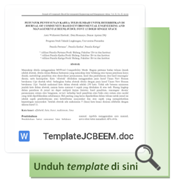Selection of Unit Design for Teluk Buyung 4 Water Treatment Plant (WTP), Bekasi City, West Java, Indonesia
DOI:
https://doi.org/10.23969/jcbeem.v6i2.6069Keywords:
water treatment plant, Teluk Buyung WTP, water quality, drinking waterAbstract
The city of Bekasi is experiencing rapid development so the demand for water is increasing. To increase service coverage and meet the drinking water needs of the people of Bekasi City with a quality that meets the Minister of Health Regulation No. 492 of 2010, it is planned to up rate the capacity that the Teluk Buyung 4 WTP has a capacity of 300 L/second with a raw water source, namely the West Tarum Secondary Channel. The Teluk Buyung 4 WTP is planned to use the design criteria from the Equivalent WTP evaluation, namely Teluk Buyung 3 WTP and literature studies. Teluk Buyung 4 WTP uses processing units, intake unit, hydraulic coagulation, hydraulic flocculation, plate settler sedimentation, rapid sand filtration, disinfection, and reservoir. The data used in the planning process is divided into two, namely primary data and secondary data. The intake unit has several components, namely a barscreen, sluice gate, carrier channel, and collecting well. The pre-sedimentation unit consists of 2 tanks and is channeled to a collection well and then pumped to the WTP. The coagulation unit uses hydraulic coagulation with a plunge of 1 tub. The coagulant used was PAC at a dose of 25 mg/L. The flocculation unit uses hydraulic flocculation with up and down flow with 2 tubs. The sedimentation unit uses a plate settler with 2 tanks. The filtration unit uses a rapid sand filter with dual media, namely anthracite media and sand media and has 7 tubs. Disinfection process uses NaOCl with a dose of 41.67 mg/L. The reservoir unit uses 1 tub with a ground reservoir type.
Downloads
References
Bhaskoro, R. G. E., Ramadhan, T. (2018). Evaluasi Kinerja Instalasi Pengolahan Air Minum (IPAM) Karangpilang I PDAM Surya Sembada Kota Surabaya Secara Kuantitatif. Jurnal Presipitasi, 15(2), 62-68.
Crittenden, J., Trussell, R., Hand, D., Howe, K., & Tchobanoglous, G. (2012). MWH's Water Treatment: Principles and Designs (3rd ed.). John Wiley & Sons, Inc.
Fair, G. M., Geyer, J. C., & Okun, D. A. (1968). Water and Wastewater Engineering (Vol. 2. Water Purification and Wastewater Treatment and Disposal). John Wiley and Sons, Inc.
Gabrielle, H & Kusumadewi, R & Ratnaningsih,. (2021). Optimisation of degreemont water treatment package on Kedung Halang water treatment plant, Bogor, West Java. IOP Conference Series: Earth and Environmental Science.
Government Regulation of the Republic of Indonesia No. 22 of 2021
Gustinawati. H. (2018). Evaluasi dan Optimalisasi Sistem Proses Pengolahan Air MInum pada Instalasi Pengolahan Air Jaluko Kabupaten Muaro Jambi. Jurnal Daur Lingkungan, 1(2).,29-30.
Harmiyati. (2018). Tinjauan Proses Pengolahan Air Baku (Raw Water) Menjadi Air Bersih Pada Sarana Penyediaan Air Minum (SPAM) Kecamatan Rangsang Kabupaten Kepualuan Meranti. Jurnal Saintis, 18(1), 1-15.
Kawamura, S. (2000). Integrated Design and Operation of Water Treatment Facilities (2nd ed.). (John Willey & Sons, Inc.).
Minister of Health Regulation of Republic Indonesia No. 492 of 2010.
Montgomery, J. (1985). Water Treatment Principle and Design. John Wiley and Sons, Inc.
Pratama, G. A. P., Dewi, E., & Meidinariasty, A. (2021). Proses Pengolahan Air Pada Prasedimentasi Ditinjau dari Laju Alir dan Waktu Pengendapan Di PLTG Borang. Jurnal Pendidikan Dan Teknologi Indonesia, 1(8), 339-343.
Qasim, S.R, Motley, E.M, dan Zhu, G. (2000). Water Works Engineering: Planning, Design, and Operation. London: Prentice–Hall.
Radityaningrum, A. D. (2017). Penurunan BOD5, COD, dan TSS pada Limbah Cair Industri Batik dengan Koagulan PAC pada Proses Koagulasi Flokulasi. Prosiding Seminar Nasional Sains dan Teknologi Terapan V.
Reynolds. (1982). Unit Operations and Processes in Environmental Engineering. California: Wadsworth. Inc.
Reynolds, T. D., & Richards, P. A. (1996). Unit Operations and Processes in Environmental Engineering (Second Edition). PWS Publishing Company.
Kusumadewi, R., Sani, I., & Winarni, W. (2019). The Use of Multi-criteria Analysis in Selecting Water Treatment Units in Sadu Water Treatment Plant, Bandung District, West Java Province, Indonesia. Journal Of Community Based Environmental Engineering And Management, 3(2), 65-78.
Rumbino, Y., & Abigael, K. (2020). Determination of the rate of deposition of particles in the Aie Reservoir Pond as a result of washing manganese ore. Journal of Technology, 14(1), 55-59.
Sani, I. K & Kusumadewi, R & Ratnaningsih,. (2020). Optimization of Cipageran water treatment plant, Cimahi, West Java, Indonesia. IOP Conference Series: Earth and Environmental Science.
Yulianti, P. (2012). Desain Unit Prasedimentasi Instalasi Pengolahan Air Minum. Jurusan Teknik Lingkungan, Institut Teknologi Sepuluh Nopember. Surabaya.














